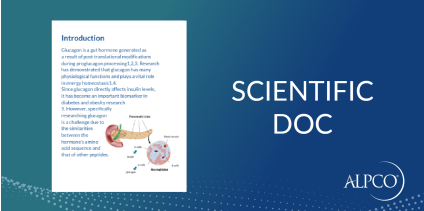November 6, 2018
The Relationship Between Glucagon and Energy Homeostasis
Glucagon is a gut hormone generated as a result of post translational modifications during proglucagon processing in the pancreas1,2,3. Research has demonstrated that glucagon has many physiological functions1,4. Understanding the role of glucagon in energy homeostasis has become important to many diabetes and obesity researchers5. However, researching the relationship between glucagon and energy homeostasis is a challenge due the similarities between the glucagon amino acid sequence and that of other peptides2,6.
Download our eBook to learn about the role glucagon plays in energy homeostasis and how similarities between the glucagon sequence and other peptides create analytical challenges for diabetes researchers.
Download eBook
 Figure 1: Proglucagon processing in the pancreas generates glucagon as well as three inactive fragments: glicentin-related pancreatic peptide (GRPP), intervening peptide 1 (IP1), and major proglucagon fragment (MPGF)1,7[/caption]
Figure 1: Proglucagon processing in the pancreas generates glucagon as well as three inactive fragments: glicentin-related pancreatic peptide (GRPP), intervening peptide 1 (IP1), and major proglucagon fragment (MPGF)1,7[/caption]
 Figure 2: Types of cells found in the pancreas. Pancreatic beta cells produce insulin and alpha cells produce glucagon. Both hormones regulate each other to promote energy homeostasis13.[/caption]
Figure 2: Types of cells found in the pancreas. Pancreatic beta cells produce insulin and alpha cells produce glucagon. Both hormones regulate each other to promote energy homeostasis13.[/caption]
 Figure 3: Glucagon Amino Acid Sequence Similarities with other Proglucagon Peptides. The glucagon amino acid sequence is found within glicentin and oxyntomodulin1,3,16,17.[/caption]
Figure 3: Glucagon Amino Acid Sequence Similarities with other Proglucagon Peptides. The glucagon amino acid sequence is found within glicentin and oxyntomodulin1,3,16,17.[/caption]
The Process of Generating Glucagon
The process of generating glucagon begins with the synthesis of preproglucagon (PPG), the single precursor to all of the proglucagon peptides1. Research in rodents and humans has shown that the synthesis of preproglucagon is highly regulated and performed by several different tissues and cells throughout the body1,7,8,9,10.Summary of Proglucagon Processing
Once preproglucagon is formed, it undergoes a series of post translational modifications (PTMs) triggered by different physiological, neurological, and endocrine cues1. The first PTM generates the proglucagon molecule1. Additional tissue, cell, and enzyme-specific PTMs result in the production of the proglucagon peptide family1,7.Pancreatic Post Translational Modifications
Research indicates that the majority of glucagon is produced by α-cells in the pancreas1. The enzyme PC2 is responsible for processing proglucagon produced by the α-cells and requires the chaperone protein 7B2 to cleave proglucagon in the pancreas7. The cleavages generate glucagon as well as three additional inactive peptide fragments1. [caption id="attachment_5117" align="alignnone" width="678"] Figure 1: Proglucagon processing in the pancreas generates glucagon as well as three inactive fragments: glicentin-related pancreatic peptide (GRPP), intervening peptide 1 (IP1), and major proglucagon fragment (MPGF)1,7[/caption]
Figure 1: Proglucagon processing in the pancreas generates glucagon as well as three inactive fragments: glicentin-related pancreatic peptide (GRPP), intervening peptide 1 (IP1), and major proglucagon fragment (MPGF)1,7[/caption]
The Functions of Glucagon
Research demonstrates that the glucagon receptor (GCGR) is mainly located in the liver, but is also expressed in the kidneys, adipose tissue, pancreas, brain, and gastrointestinal tract2,6. Glucagon has different physiological functions depending on where the receptor is located1,2,6,11,12.The Role of Glucagon in Energy Homeostasis
One of the most important functions of glucagon is the role it plays in energy13. Glucagon works with insulin via the insulin glucagon ratio (IGR) which serves as a molecular balance for regulating carbohydrate and lipid metabolism13. [caption id="attachment_5119" align="alignnone" width="414"] Figure 2: Types of cells found in the pancreas. Pancreatic beta cells produce insulin and alpha cells produce glucagon. Both hormones regulate each other to promote energy homeostasis13.[/caption]
Figure 2: Types of cells found in the pancreas. Pancreatic beta cells produce insulin and alpha cells produce glucagon. Both hormones regulate each other to promote energy homeostasis13.[/caption]
Low Insulin Glucagon Ratio
When the IGR is low, blood glucose levels are low and glucagon is secreted from pancreatic α-cells into the portal vein of the liver1,2,13. In the liver, glucagon causes blood glucose levels to increase1,2,13.High Insulin Glucagon Ratio
An influx of glucose from the liver into the blood caused by glucagon’s actions sends signals to pancreatic β-cells to release insulin, thus increasing the IGR5.Insulin then promotes the cellular uptake of the newly available glucose and suppresses glucagon secretion. As a result, the liver stops producing glucose and prevents the development of a hyperglycemic state1,2,5,13.Regulation of Glucagon Secretion
In addition to insulin and blood glucose levels, research suggests that there are many other regulators of glucagon secretion including:- Other hormones
- Metabolic factors
- The nervous system3,15
Researching the Relationship Between Glucagon and Energy Homeostasis
Due to the role of glucagon in energy homeostasis, the hormone is an important biomarker in the effort to understand diabetes. Research has established that abnormal glucagon secretion from α-cells plays an important role in diabetes14. The increase in glucagon concentration may lead to excessive glucose production in the liver and contribute to hyperglycemia14. The exact cause of increased glucagon in type 2 diabetics has not yet been fully explained, but several theories exist15.Glucagon and Therapies for Type 2 Diabetes
Glucagon is a target for diabetes therapy development1. Researchers are continuously working towards developing new personalized diabetes therapies that specifically target glucagon13. Many types of diabetes drugs have been shown to decrease glucagon levels while restoring blood glucose levels in individuals with T2D15. However, many researchers agree that glucagon measurement needs to be incorporated into more study designs to gain a better understanding of these drugs3,5,13.The Glucagon Amino Acid Sequence
Although researchers know that measuring glucagon in their experimental design is key to fully understanding diabetes, glucagon’s 29 amino sequence poses challenges in the laboratory. First, the hormone’s amino acid sequence is found within several proglucagon peptides including glicentin and oxyntomodulin1. The similar sequence homology between glucagon and these peptide hormones has created challenges in being able to specifically measure changes in glucagon concentrations3,16,17. [caption id="attachment_5118" align="alignnone" width="719"] Figure 3: Glucagon Amino Acid Sequence Similarities with other Proglucagon Peptides. The glucagon amino acid sequence is found within glicentin and oxyntomodulin1,3,16,17.[/caption]
Figure 3: Glucagon Amino Acid Sequence Similarities with other Proglucagon Peptides. The glucagon amino acid sequence is found within glicentin and oxyntomodulin1,3,16,17.[/caption]
Glucagon and the Incretin Hormones
In addition to sharing sequence homology with glicentin and oxyntomodulin, glucagon's sequence is similar to the incretin hormones glucagon-like peptide-1 (GLP-1) and glucose-dependent insulinotropic polypeptide (GIP) 1,6. These sequence similarities create further challenges for researchers trying to specifically measure glucagon3.Conclusion
Glucagon is a gut hormone generated mainly by proglucagon processing in pancreatic α-cells1,2,3. The role of glucagon in energy homeostasis is vital since it acts as a counter regulatory balance to insulin via the IGR13. Glucagon secretion is tightly regulated3,15, but research suggests that its abnormal secretion is a key component in the development of type 2 diabetes14. As a result, many research teams continue to investigate the relationship between glucagon and energy homeostasis in order to personalize diabetes care13. However, the glucagon amino acid sequence is found within multiple proglucagon peptides and is similar to incretin hormones1,6 which creates analytical challenges for diabetes laboratories1,23. Therefore, an improved method for specifically measuring glucagon would benefit researchers as they work to develop more personalized diabetes treatments. Download our eBook to learn about the role glucagon plays in energy homeostasis and how similarities between the glucagon sequence and other peptides create analytical challenges for diabetes researchers. Download eBookReferences
- Sandoval and D’Alessio (2015). Physiology of Proglucagon peptides: Role of glucagon and GLP-1 in health and disease. Physiol Rev 95: 513-548. PMID: 25834231.
- Müller, et al (2017). The New Biology and Pharmacology of Glucagon. Physiol Rev. 2017 Apr;97(2):721-766. PMID: 28275047.
- Wewer Albrechsten, et al (2016). The biology of glucagon and the consequences of hyperglucagonemia. Biomark Med. 2016 Nov;10(11):1141-1151. PMID: 27611762.
- Drucker and Campbell (2015). Islet α-cells and glucagon—critical regulators of energy homeostasis. Nature Reviews Endocrinology 11(6): 329-339. PMID: 25850661
- Haedersdal, et al (2018). The Role of Glucagon in The Pathophysiology and Treatment of Type 2 Diabetes. Mayo Clin Proc. 2018 Feb;93(2):217-239. PMID: 29307553.
- Brubaker and Drucker (2002). Structure-Function of the Glucagon Receptor Family of G Protein-Coupled Receptors: The Glucagon, GIP, GLP-1, and GLP-1 Receptors. Receptors Channels. 2002;8(3-4):179-88. PMID: 12529935.
- Kim and Egan (2008). The Role of Incretins in Glucose Homeostasis and Diabetes Treatment. Pharmacol Rev. 2008 Dec;60(4):470-512. PMID: 19074620.
- Jin (2008). Mechanisms underlying proglucagon gene expression. J Endocrinol. 2008 Jul;198(1):17-28. doi: 10.1677/JOE-08-0085. PMID: 18577568.
- Shao, et al (2013). The Wnt Signaling Pathway Effector TCF7L2 Controls Gut and Brain Proglucagon Gene Expression and Glucose Homeostasis. 2013 Mar; 62(3): 789–800. PMID: 22966074.
- Trapp and Cork (2015). PPG neurons of the lower brain stem and their role in brain GLP-1 receptor activation. Am J Physiol Regul Integr Comp Physiol. 2015 Oct 15;309(8):R795-804. PMID: 26290108.
- Habegger, et al (2010). The metabolic actions of glucagon revisited. Nat. Rev. Endocrinol. 6, 689–697. PMCID: PMC3563428
- Tan, et al (2013). Co-administration of glucagon-like peptide‑1 during glucagon infusion in man results in increased energy expenditure and amelioration of hyperglycemia. Diabetes 62, 1131–1138. oi: 10.2337/db12-0797. PMCID: PMC3609580.
- Kalra and Gupta (2016). The Insulin:Glucagon Ratio and the Choice of Glucose-Lowering Drugs. Diabetes Ther. 2016 Mar; 7(1): 1–9. PMID: 26965024.
- D’Alessio (2011). The role of dysregulated glucagon secretion in type 2 diabetes. Diabetes Obes Metab.2011 Oct;13 Suppl 1:126-32. PMID: 21824266.
- Godoy-Matos (2014). The role of glucagon on type 2 diabetes at a glance. Diabetol Metab Syndr.2014 Aug 24;6(1):91. doi: 10.1186/1758-5996-6-91. PMID: 25177371.
- Pacific Biomarkers (2013). Incretins and Gastrointestinal Hormones: Pathophysiology and Pre-analytical Considerations. pacbio.com.
- Drucker Labs (2015). Oxyntomodulin. Glucagon.com.

